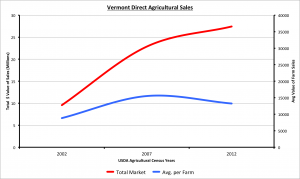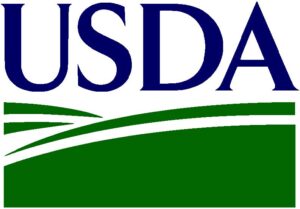By Suzy Hodgson
Editor’s Note: This article is adapted from Rose Wilson’s presentation MARKETING 201: Helping Farmers Stay Competitive in a Maturing Market, National Farm Viability Conference, Albany, 2017.
“As local food markets mature and competition increases, it’s becoming harder for experienced farmers to maintain market share and new farmers to break in”, says Rose Wilson, business development expert. In a maturing market, while overall direct sales of Vermont farms are increasing, the rate of growth is decreasing.
This means that for Vermont farmers, the average revenue per farmer is faltering as more farms and more local food add to the competition. USDA Vermont census data shows that total direct agricultural sales continued to increase from 2007 to 2012, but the rate of increase declined and the average sales per farm dropped from $15,511 in 2007 to $13,245 in 2012. As for the past five years, Erin Buckwalter, NOFA VT’s Market Development Director adds,
The number of farmers markets in Vermont has stabilized between 70 and 75 with a couple new ones starting up and a couple closing down.
While Erin sends surveys to Vermont farmers markets each year, she says, “it’s difficult to identify overall revenue trends as the 50% of farmers markets who report are not always the same 50% from the previous year so data comparisons made in the aggregate are not that useful.” This year NOFA is working with a group of five markets more closely to see how their data can be collected and analyzed in such as way to make it more useful for decision making.
Increasing competition also means that big brands and stores have joined the marketplace with greater professionalism so that maintaining market share and retaining customers require more effort. The farms that will survive and thrive in a mature market:
- Understand their customers
- Use market segmentation
- Are able to innovate with new products, services, and distribution channels,.
- Have a strong brand
- Can withstand price pressure
- Provide a great customer experience
- Focus on increasing communication and visibility
In maturing markets, farms need not only the early adopters and avid localvores, but also need to appeal to a broader and less committed audience. New potential consumers, less committed to core values of local food, will give greater weight to price and convenience in their decision, to buy or not to buy. A typical new product adoption curve encompasses:
- Innovators: First people to join a CSA
- Early Adopters: Farmers market regulars
- Early Majority: Whole Foods, Co-op shoppers
- Late Majority: Walmart, Supermarket shoppers
- Laggards: Not driven by values, unlikely to seek out local food
With local food now mainstream, this is a key time to use market research and assess your target markets. Who are your customers now, and who could be your customers tomorrow?
More mainstream new customers will expect you to come to them as they have plenty of providers and choices available.
Here are some tips to help farmers identify market trends and differentiate themselves:
- Make a list of all the different types of people (e.g., mom, athletes, families, single folks, sports fans, millenials, baby boomers, ethnicities, income levels, avid readers, animal lovers, nature enthusiasts, etc.).
- Describe the characteristics of each audience. Each will have different needs, habits, expectations, motivations, interests, values, and methods of communication.
- Research what is important to them, how to package, price and communicate a message which resonates and can acted upon.
- Evaluate methods of communication–where do customers shop, how do they absorb information, where do they learn about new products/services–do they read newspapers/magazines, listen to the radio, watch TV, use the web, text, e-mail. If social media, which channels–Facebook, Instagram?
Within this larger community of consumers are many little communities, each trying to be heard and represented. You’re likely to find that as unit margins go down, the volume of units may go up, or profits from new services or products offset lower profits from mature products. So, all in all, you can continue to grow or stabilize your market.
For example, in February, Jasper Hill titled its e-newsletter “We’ve Got Game Time Snacks Covered!” Jasper Hill is turning to mainstream America to attract a new market of Superbowl fans, not the typical high-end cheese audience. In addition to the football message, the company has now created a more convenient product for everyday cooking. Importantly, the cheese didn’t change, but it now comes in a pre-selected cooking blend, pre-shredded, in a resealable Ziplock bag. Similarly, farmers and local food companies which provide meal kits have a strategy for to respond to the demand for convenience.

Jasper Hill original product… New convenience offering. Rose Wilson, National Viability Conference, 2017
Even when there’s not a lot to communicate, big brands have learned that there are opportunities to rebrand by updating packaging or tweaking a product attribute as in “new look, same great taste!”; “new and improved!”
- Can your product benefit from a different form, packaging, logo, tagline, and/or marketing materials?
- Can you offer deals, sales, and incentives?
- Can you cultivate brand loyalty in your existing customer base such that they still choose you over new competing entrants to the marketplace?
- Do you have a contingency plan; if you can’t alter price, how will you communicate features and benefits, which make your product unique to maintain customer loyalty?
Innovation can mean inventing something new but not necessarily–it can simply mean producing, packaging or serving your product or your audience differently than before to retain or grab their attention. As the market matures and there are many more places to buy local food, the product begins to matter less and the customer service begins to matter more. This means it’s time to evaluate your customer service. How could you be doing a better job?
- Personalization matters: the customer needs to feel you’re speaking to their personal needs and interests. Sincerity matters.
- Attitude and Demeanor matter: all staff and answering tools (automated v-mail, e-mail, etc.) need have a friendly and helpful voice.
- Packaging and point of sale need to provide price, product & clear product attributes and usage information–people read labels and do want to know what things cost.
Communication & Visibility
When brands face increasing competition and consumers have more choices, communicating unique strengths and benefits is more important than ever. Successful farmers find reasons to communicate with customers and do it regularly. Repetition and more frequent communication can be a useful service to customers. Jasper Hill sends out an e-mail every two weeks, whether or not they have something “noteworthy” to report. Three Cow Creamery started sending out an e-mail before a farmers market, reminding people to come and telling folks what happened that week on the farm. Even if the e-mail isn’t read, its subject title, if clear and concise, can be a good reminder about an upcoming farmers market.
Messages can also be linked to memorable days and actions e.g., Earth Day or Father’s Day flash sale or regular reminders about CSA pick up times. Don’t forget key information such as phone number, e-mail, address and open times. A combination of off-line (e.g., postcards, signage) and on-line messages through social media can reinforces your messaging. And take advantage of free directories, such as your Chamber of Commerce, County food publications such as Addison’s Guide to Local Foods and Farms, as well as free online directories such as Google My Business and Bing Places
In a nutshell, in a mature market, farmers need differentiated messages to convey their brand, products, and services repeatedly to reach each target audience using a mix of channels have been researched as effective. The fundamentals–a great product, a strong brand, and responsive customer service— will remain the foundation of a marketing strategy to thrive in the local food marketplace. Need help? Contact UVM Extension’s Farm Viability Team , Rose J. Wilson Business Development Services, and Vermont’s Small Business Development Center.
This article is adapted from Rose Wilson’s presentation MARKETING 201: Helping Farmers Stay Competitive in a Maturing Market, National Farm Viability Conference, Albany, 2017.








